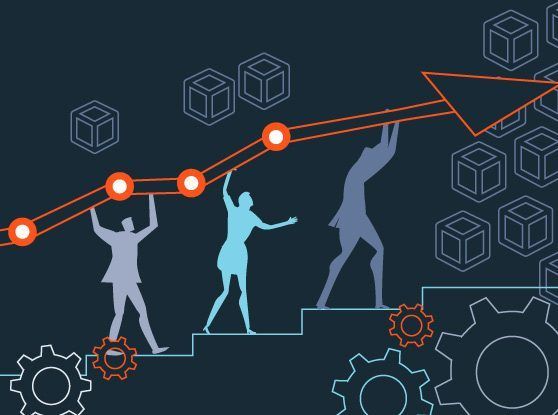Artificial Intelligence
The what?
AI and machine learning has emerged as one of the most important phenomenon in technology today. In particular, neural networks and deep learning have shown sudden improvements in performance that have surprised even the most experienced machine learning practitioners. The landscape has started to shift away from consulting companies doing custom, bespoke projects. In 2017, we saw the emergence of real software companies selling turnkey cross-industry applications with machine learning at their core, in domains such as cybersecurity, fraud detection, and churn analytics. Many of these new applications being fueled by machine learning and AI are built on open source infrastructure being made available by vendors such as Google and Amazon Web Services, who developed the capabilities for internal use and are now making them available through their public cloud infrastructure platforms.
2018 and beyond
In 2018, machine learning and AI will continue to move up the stack, as vendors who have created use case-specific applications across industries as varied as healthcare, education, retail, financial services, and government start to achieve scale. Machine learning will be a key ingredient in the next generation of software applications. With AI-powered, industry-specific applications, scale can provide the largest and fastest growing vendor in each segment with an insurmountable data advantage—on top of all of the usual brand and cost advantages enjoyed by the scale leader in software. More customers will result in a better product, with value accruing to all of a vendor’s customers as well as to the vendor iteself and its investors. There will also be an increase in “machine learning theatrics” as companies pretend to use machine learning to get improved valuations.
Blockchain
The what?
Blockchain technology, underpinning Bitcoin and hundreds of other cryptocurrencies and distributed cryptographic systems, represents the integration of three key innovations: proof of work, public key cryptography, and distributed ledger technology. Blockchains and their associated cryptocurrencies allow for the creation of a tamper-proof public ledger for recording information or running programs—a kind of distributed, immutable database that doesn't rely on management by a central entity like a large corporation. A well-designed blockchain can provide both an incentive for participants to run the distributed ledger and computation system, as well as a cryptographic distributed consensus mechanism that maintains the system’s integrity even if all of the participants don’t trust each other.
2018 and beyond
As the market capitalization of cryptocurrencies exceeded $600 billion, with Bitcoin alone trading at a market cap of more than three times that of Goldman Sachs, 2017 also saw the emergence of the “Initial Coin Offering.” High profile, early-stage projects such as Filecoin raised hundreds of millions of dollars in capital in mere hours. Some big-name VCs have amended their charters to allow them to acquire and serve as custodians for cryptocurrency tokens. The Long Island Ice Tea Co. changed its name to Long Blockchain and saw its market cap increase by more than 300%, as did multiple other publically traded companies, raising the specter of the .com excesses of the late 1990s. Legacy companies have started to market distributed database technologies as “private blockchains” to ride the wave. The global computer network running the Bitcoin blockchain alone is consuming more energy than of 150 of the world’s countries, causing concern over the sustainability of more energy-intensive consensus mechanisms such as proof-of-work. While few blockchains have seen real traction beyond the speculation use case, the large influx of capital is driving real innovation in technology and protocols that may power a new generation of companies. In particular, blockchains and cryptocurrencies are showing promise as a way to incentivize early participants in a network to participate a system before scale network effects kick in. This could help marketplace-style businesses and lower-level computing protocols and platforms achieve “escape velocity” and enjoy network effects more quickly.
CRISPR
The what?
The CRISPR gene editing technique, adapted from the immune system of bacteria, allows researchers to edit DNA at precise locations, turning off or on specific gene expressions. Over the last few years, CRISPR has been used for a wide variety of accomplishments, including removing Huntington’s disease from the genes of mice, improving the biofuel production capacity of algae, slowing the growth of cancer cells, creating synthetic bacteria-like organisms, and removing HIV from cells.
2018 and beyond
Progress applying CRISPR technology to new use cases is proceeding at a rapid pace, and there is a corresponding large body of activity—in many ways still in its infancy—around applying advanced computer modeling and machine learning techniques to genomic analysis. Advanced computer software and enormous amounts of data are needed to allow scientists to determine which genes to edit and how to edit them to get desired results. As with machine learning, increasing success with CRISPR technology will provoke an important, global conversation to tackle questions of ethics and safety.
Drones
The what?
Most people think of unmanned aircraft systems (UAS), a.k.a. drones, as a stealth military technology or an expensive “toy” for geeks. Businesses are realizing that drones have multiple commercial applications beyond basic surveillance or video, and they are starting to use them in daily work activities. For example, insurance companies are using drones to inspect damaged assets, and farmers are sending them to monitor crops and collect soil data. Even more dramatic changes could be in store as companies like Amazon explore drone delivery services and workers commute via air taxis, which were tested by Volocopter in Dubai in 2017.
2018 and beyond
In the U.S., the commercial value of drone activity has grown from $40 million in 2012 to about $1 billion in 2017. By 2026, a McKinsey Global Institute study estimates drone impact will be $46 billion on the country’s GDP. This does not include the military, security, and intelligence applications which are already advanced. Developments within the United States could signal how commercial drone usage and investment will unfold in other markets. In the interim, there is still a lot of progress to be made in technology improvements, public acceptance, and regulation. The software ecosystem around drones is still in its infancy, without clear leaders, and with battery performance, GPS, and collision avoidance systems improving rapidly. Regulators will evaluate the implications of new UAS uses, including potential safety issues, before they reach the market. That means the regulatory process and timeline will ultimately determine when many UAS applications become viable.
Everything-On-Demand
The what?
Instant gratification of consumer needs has always been the holy grail. Consumers are notoriously impatient and fickle, wanting their goods as fast as possible, or they take their business elsewhere. Amazon has emerged as a leader in this area, building strong logistics networks and betting that by making delivery of goods as convenient and fast as possible they will own the consumer. Other companies have followed suit. The valuations and investment in companies like Instacart, Google Express, and Postmates show that instant access is about to transform supply and local distribution networks. The last mile is the new frontier.
2018 and beyond
BI Intelligence projects the same-day delivery market will grow to $4.03 billion in 2018. The trend is growing globally: Cainiao Network, the logistics arm of Alibaba, is deploying AI technology in its courier network by putting one million smart logistics vehicles into the market to cope with growing future delivery volumes, which are anticipated to reach one billion a day within a decade. The nature of smart logistics is the flow of data and sophisticated supply networks. Uber began the trend with on-demand taxis; every product or service is now subject to the everything-on-demand consumer requirement.
Future is Quantum
The what?
Over 35 years ago, Richard Feynman proposed the idea of creating a quantum computer by using the subatomic properties of matter to build processors that can exist in multiple states simultaneously. Even though the hardware was yet to be built, over the ensuing decades, computer scientists designed software algorithms that could take advantage of such quantum computing capabilities. For example, Shor’s Algorithm was developed in 1994, which, if run on a sophisticated enough quantum computer, could render much of the world’s encryption defenseless. In recent years, “moonshot” R&D investments by large companies such as Google, Microsoft, and IBM, research universities, and startups such as Rigetti Computing have started producing functional quantum computing hardware, albeit at a small scale and without the error correction capabilities needed for many algorithms.
2018 and beyond
Recent quantum hardware announcements from companies like IBM and Google have showcased beautiful machines featuring up to 50 unreliable quantum bits or qubits. Google has said publicly that while computers with large-scale quantum processors are likely still a decade or more away, there are a number of quantum use cases they expect to be able to address sooner, given the current state of the hardware. These include simulation, optimization, and sampling computational workloads, for which quantum computers can be better suited versus conventional computers.
In scope for quantum computers in the near-term may be capabilities such as recommendation engines, scheduling and planning logistics systems, search, and bidding optimization—all of which are proving to be important competitive differentiators in various industries. In the meantime, security companies are working on quantum-resistant algorithms to defend encrypted data, which will become vulnerable as soon as reliable quantum computers capable of running Shor’s algorithm come online.
GDPR
The what?
GDPR, or the General Data Protection Regulation, is the EU’s most aggressive and pervasive privacy protection regulation ever enacted. The components of the law are extensive and the potential fines for non-compliance are breathtaking: 20 million Euros or 4% of worldwide revenue—whichever is greater. While the EU is enacting the GDPR, it impacts organizations globally. Both businesses in the EU and businesses marketing in the EU need to abide by the new regulation. Some of the requirements include the “right to be forgotten,” opt-in (not opt-out) lists, and the establishment of the Data Protection Officer (DPO). These are just some of many rules that have left organizations scrambling to map out their compliance strategy.
2018 and beyond
The key understanding of GDPR is that it doesn’t simply impact one area of an organization. Instead, it demands a holistic approach to deal with this sweeping piece of legislation effectively. In 2018, Legal, IT, and Marketing/Sales will need to coordinate their strategies for bringing an organization into compliance. GDPR takes effect on May 25, but it will take all of 2018 and beyond for organizations to get the proper guidance from the EU on the many poorly-defined sections of the law. The clock has already started—now is the time to get your organization GDPR ready before most far-reaching privacy law takes effect. Last year, we launched a webinar series on GDPR's legal, tech and marketing implications, which you can watch here.
High Velocity IT
The what?
According to Gartner, Amazon Web Services took over 44% of the cloud infrastructure as a service market in 2017, which is more than 2x of all of the rest of the companies they evaluated combined. With an $18 billion per year run rate, growing at over 42% compounded, AWS has millions of active customers across all industries. Each year at its annual developer conference, AWS releases dozens of new products across domains such as security software, machine learning, management software, and data management, threatening more and more of the traditional enterprise software space with elastic products that can be less than 1/10 the cost of their on-premise, less elastic counterparts. Enterprise customers adopting AWS and similar public cloud platforms are able to focus on building higher-level business logic, leaving much of the work of managing IT systems behind, dramatically increasing the speed with which they can release and scale new functionality.
2018 and beyond
In an attempt to catch up to AWS, other public cloud providers, such as Microsoft and Google, are making huge investments in their public cloud platforms. They are continuously dropping their prices to match AWS's already low and rapidly dropping prices. Customers are starting to realize that it is a misconception that the public cloud is less secure than on premise systems. They also are realizing that companies such as Equifax, Target, and Sony are no match for AWS and Google when it comes to cybersecurity capabilities, and enterprises will increasingly want to be within the protective glow of the most sophisticated public cloud platforms to secure their applications and data.
The new AWS Secret Region has allowed the CIA and 17 other intelligence agencies to leverage the public cloud, and Goldman Sachs is moving a large portion of its IT infrastructure to AWS using the new “bring your own encryption keys” capability of the platform. AWS and Google are leveraging the increasing sophistication of open source infrastructure software, such as the PostgreSQL database and the Kubernetes container orchestration framework, to power their public cloud offerings -- effectively crowdsourcing much of the R&D effort. Legacy players like Oracle are caught in a vicious cycle of raising prices on customers and cutting spending on innovation. Large portions of the traditional enterprise software vendor landscape are at risk of the fate that befell the traditional retailers who failed to adapt to Amazon’s entry into retail.
Inclusion
The what?
From the first revelations by a female Uber engineer, to further revelations of the impact of the lack of diversity in tech—Google’s firing of a male engineer for discrimination, an emerging list of sexual harassment cases among VC and tech startups, the tide of #MeToo stories flooding social media—2017 was a year in which tech’s obvious lack of diversity, especially in STEM positions, has been part of a broader national conversation on the topic.
2018 and beyond
Diversity is in the spotlight, but inclusion is the holy grail. Inclusive practice in education—the attitudes, approaches, and strategies implemented to ensure that students are not excluded from the learning environment because of their differences—has been known to teachers for many years. Understanding of these techniques is starting to build in the workplace. For growth stage companies, the key is to begin immediately—the longer a company waits to build a diverse workforce and inclusive culture, the harder it will be in the future. In 2018, diversity and inclusion will continue to be front and center; we likely have not yet seen the full exposure of senior leaders who have engaged in inappropriate workplace behavior. Expect more #MeToo; this will continue to be a Board level topic.
Japan aka SoftBank
The what?
Backed by sovereign wealth funds and tech behemoths alike, the Japanese Softbank’s Vision Fund, at $98 billion, is not just the largest tech fund ever, it’s the largest corporate venture capital fund ever, according to data from FactSet. Vision Fund has both awed and reshaped Silicon Valley financiers with its focus on investing in some of the largest systems on the planet—energy, transportation, the internet and food—and its seeming indifference to historical valuation ranges.
2018 and beyond
With the Vision Fund, billionaire Masayoshi Son is looking to increase his influence as a tech investor, wagering on the future of AI, connected devices, and the integration of computers and humans. His influence will increase if he raises an additional fund (purportedly under consideration) with significant support from Saudi Arabia’s Crown Prince, Mohammed bin Salman. The implications are good and bad. On one hand, Son may disintermediate existing VC funds who can’t pay up for deals with the same alacrity given their shorter-term time horizons. He is also investing across the deal lifecycle, in seed stage startups, growth stage and public entities. On the other hand, Vision Fund could present a new source of VC exits. Son has said publicly that tech is in a period of change and that those who make major investments now in new technologies—like automation and AI—will reap the biggest rewards later.










